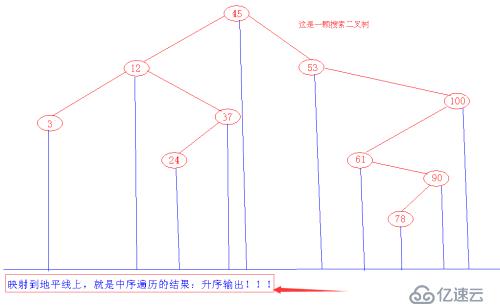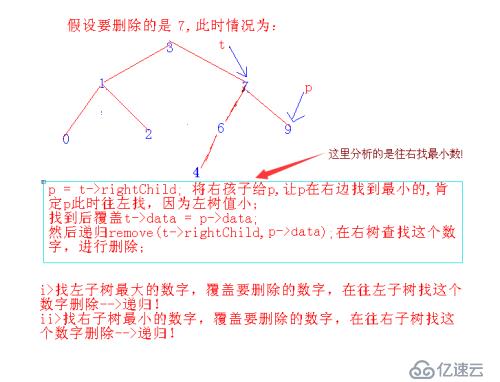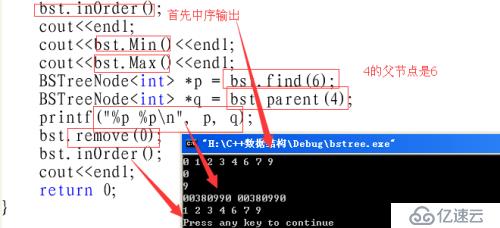жӮЁеҘҪпјҢзҷ»еҪ•еҗҺжүҚиғҪдёӢи®ўеҚ•е“ҰпјҒ
жӮЁеҘҪпјҢзҷ»еҪ•еҗҺжүҚиғҪдёӢи®ўеҚ•е“ҰпјҒ
1гҖҒдәҢеҸүжҗңзҙўж ‘
(1)гҖҒйҖјиҝ‘жҠҳеҚҠжҹҘжүҫзҡ„жҹҘжүҫз®—жі•пјӣ
(2)гҖҒдёҖиҲ¬дёҚе…Ғи®ёеҮәзҺ°йҮҚеӨҚж•°еӯ—пјҢдёҚ然没法еӯҳеӮЁпјӣ
(3)гҖҒж»Ўи¶іпјҡе·Ұеӯ©еӯҗж•°жҚ® < ж №з»“зӮ№ж•°жҚ® < еҸіеӯ©еӯҗж•°жҚ®пјӣж №(зҲ¶)з»“зӮ№жҜ”е·Ұеӯ©еӯҗзҡ„еӨ§пјҢжҜ”еҸіеӯ©еӯҗзҡ„е°Ҹпјӣ
(4)е·Ұеӯҗж ‘е’ҢеҸіеӯҗж ‘д№ҹжҳҜдәҢеҸүжҗңзҙўж ‘пјӣ
2гҖҒдёәд»Җд№ҲеҸ«дәҢеҸүжҗңзҙўж ‘пјҹ
еҰӮжһңеҜ№дёҖйў—дәҢеҸүжҗңзҙўж ‘иҝӣиЎҢдёӯеәҸйҒҚеҺҶпјҢеҸҜд»ҘжҢүд»Һе°ҸеҲ°еӨ§зҡ„йЎәеәҸиҫ“еҮәпјҢжӯӨж—¶еҸҲеҸ«еҒҡдәҢеҸүжҺ’еәҸж ‘гҖӮ
еҰӮеӣҫпјҡ

3гҖҒжҗңзҙўдәҢеҸүж ‘дёҠзҡ„ж“ҚдҪң
е…ЁйғЁз”ЁC++е®һзҺ°зҡ„гҖӮ
(1)гҖҒд№ӢеүҚеӯҰд№ дәҢеҸүж ‘пјҢ并没жңүиҜҙд»Җд№ҲжҸ’е…ҘпјҢеҲ йҷӨж“ҚдҪңпјҢйӮЈжҳҜеӣ дёәпјҢжІЎжңү规еҫӢиҖҢиЁҖпјҢжҖҺд№ҲиҝӣиЎҢж“ҚдҪңе‘ўпјҹжҗңзҙўдәҢеҸүж ‘зҡ„规еҫӢеҰӮжӯӨжҳҺжҳҫпјҢйӮЈд№ҲжҸ’е…ҘпјҢеҲ йҷӨеҝ…жҳҜйҮҚдёӯд№ӢдёӯпјҒ
(2)гҖҒжҲ‘们иҫ“е…ҘзӣёеҗҢзҡ„ж•°еӯ—пјҢдҪҶжҳҜйЎәеәҸдёҚеҗҢзҡ„иҜқпјҢз”ҹжҲҗзҡ„жҗңзҙўдәҢеҸүж ‘жҳҜдёҚдёҖж ·зҡ„пјҒ
дҫӢпјҡint ar[] = {3, 7, 9, 1, 0, 6, 4, 2,}; е’Ңint ar[] = {7, 3, 9, 1, 0, 6, 4, 2,}; з”ҹжҲҗзҡ„жҗңзҙўдәҢеҸүж ‘дёҚдёҖж ·гҖӮ

(3)жҸ’е…ҘеҮҪж•°пјҡ
йҮҚеҲҶеҲ©з”ЁжҗңзҙўдәҢеҸүж ‘зҡ„жҖ§иҙЁпјҡ
void insert(BSTreeNode<Type> *&t, const Type &x){
if(t == NULL){
t = new BSTreeNode<Type>(x);
return;
}else if(x < t->data){
insert(t->leftChild, x);
}else if(x > t->data){
insert(t->rightChild, x);
}else{
return;
}
}(4)гҖҒеҲ йҷӨеҮҪж•°пјҡ
жҖқжғіпјҡиҰҒеҲ йҷӨдёҖдёӘжңүе·Ұеӯ©еӯҗжҲ–еҸіеӯ©еӯҗжҲ–жҳҜеҸ¶еӯҗз»“зӮ№пјҢзңӢжҲҗдёҖз§Қжғ…еҶөпјҢеҒҡжі•пјҡдҝқеӯҳиҰҒеҲ йҷӨзҡ„з»“зӮ№,еӣ дёәдј зҡ„жҳҜеј•з”ЁпјҢеҸҜд»ҘзӣҙжҺҘдҝ®ж”№дёҠдёҖдёӘз»“зӮ№зҡ„е·Ұеӯ©еӯҗжҲ–еҸіеӯ©еӯҗпјҢдҪҝе…¶и·ЁиҝҮеҪ“еүҚзҡ„зӣҙжҢҮдёӢдёҖдёӘз»“зӮ№пјҢеңЁйҮҠж”ҫеҪ“еүҚзҡ„з»“зӮ№з©әй—ҙгҖӮ
第дәҢз§Қжғ…еҶөпјҡе°ұжҳҜиҰҒеҲ йҷӨзҡ„ж—ўжңүе·Ұеӯҗж ‘пјҢеҸҲжңүеҸіеӯҗж ‘пјҢжӯӨж—¶еҸҜд»ҘжңүдёӨз§ҚеҒҡжі•пјҡi>жүҫе·Ұеӯҗж ‘жңҖеӨ§зҡ„ж•°еӯ—пјҢиҰҶзӣ–иҰҒеҲ йҷӨзҡ„ж•°еӯ—пјҢеңЁеҫҖе·Ұеӯҗж ‘жүҫиҝҷдёӘж•°еӯ—еҲ йҷӨ-->йҖ’еҪ’пјҒii>жүҫеҸіеӯҗж ‘жңҖе°Ҹзҡ„ж•°еӯ—пјҢиҰҶзӣ–иҰҒеҲ йҷӨзҡ„ж•°еӯ—пјҢеңЁеҫҖеҸіеӯҗж ‘жүҫиҝҷдёӘж•°еӯ—еҲ йҷӨ-->йҖ’еҪ’пјҒ
第дёҖз§Қжғ…еҶөеӣҫеҪўжғіжі•еҰӮдёӢпјҡ

еҲ йҷӨе·Ұиҫ№е’ҢеҲ йҷӨеҸіиҫ№пјҢиҝҳжңүжҳҜеҸ¶еӯҗз»“зӮ№пјҢжғіжі•дёҖж ·гҖӮ
第дәҢз§Қжғ…еҶөеӣҫеҪўжғіжі•еҰӮдёӢпјҡ

д»Јз ҒеҰӮдёӢпјҡ
bool remove(BSTreeNode<Type> *&t, const Type &key){
if(t == NULL){ //tдј зҡ„жҳҜеј•з”ЁпјҢжҜҸж¬ЎеҸҜд»ҘиҝӣиЎҢзӣҙжҺҘжӣҙж”№!
return false;
}
if(key < t->data){
remove(t->leftChild, key);
}else if(key > t->data){
remove(t->rightChild, key);
}else{
if(t->leftChild != NULL && t->rightChild != NULL){ //第дәҢз§Қжғ…еҶө
BSTreeNode<Type> *p = t->rightChild;
while(p->leftChild != NULL){
p = p->leftChild;
}
t->data = p->data;
remove(t->rightChild, p->data); //еңЁеҸіж ‘жүҫp->dataзҡ„ж•°еӯ—иҝӣиЎҢеҲ йҷӨ;
}else{ //第дёҖз§Қжғ…еҶө
BSTreeNode<Type> *p = t;
if(t->leftChild == NULL){
t = t->rightChild; //еј•з”Ёзҡ„еҘҪеӨ„дҪ“зҺ°еҮәжқҘдәҶ;
}else{
t = t->leftChild; //еј•з”Ёзҡ„еҘҪеӨ„дҪ“зҺ°еҮәжқҘдәҶ;
}
delete p;
}
}
return true;
}
/* д»ҘдёӢиҝҷдёӘд»Јз ҒжҳҜе…ҲжғіеҲ°зҡ„пјҢжҜ”иҫғе®№жҳ“пјҢдёҠйқўиҝҷдёӘжҳҜз»ҸиҝҮжҖқиҖғзҡ„пјҢе°Ҷдёүз§Қжғ…еҶөзңӢжҲҗдёҖз§Қжғ…еҶөжқҘеӨ„зҗҶгҖӮ
bool remove(BSTreeNode<Type> *&t, const Type &key){
if(t == NULL){
return false;
}
if(key < t->data){
remove(t->leftChild, key);
}else if(key > t->data){
remove(t->rightChild, key);
}else{ //д»ҘдёӢдёүз§Қжғ…еҶөеҸҜд»ҘзңӢжҲҗдёҖз§Қпјӣ
if(t->leftChild == NULL && t->rightChild == NULL){
delete t;
t = NULL;
}else if(t->leftChild != NULL && t->rightChild == NULL){
BSTreeNode<Type> *p = t;
t = t->leftChild;
delete p;
}else if(t->leftChild == NULL && t->rightChild != NULL){
BSTreeNode<Type> *p = t;
t = t->rightChild;
delete p;
}else{
BSTreeNode<Type> *p = t->rightChild;
while(p->leftChild != NULL){
p = p->leftChild;
}
t->data = p->data;
remove(t->rightChild, p->data);
}
}
return true;
}
*/4гҖҒжҗңзҙўдәҢеҸүж ‘зҡ„е®Ңж•ҙд»Јз ҒгҖҒжөӢиҜ•д»Јз ҒгҖҒжөӢиҜ•з»“жһң
(1)гҖҒе®Ңж•ҙд»Јз Ғпјҡ
#ifndef _BSTREE_H_
#define _BSTREE_H_
#include<iostream>
using namespace std;
#define MIN_NUMBER -8937589
#define MAX_NUMBER 99999999
template<typename Type>
class BSTree;
template<typename Type>
class BSTreeNode{
friend class BSTree<Type>;
public:
BSTreeNode() : data(Type()), leftChild(NULL), rightChild(NULL){}
BSTreeNode(Type d, BSTreeNode *left = NULL, BSTreeNode *right = NULL)
: data(d), leftChild(left), rightChild(right){}
~BSTreeNode(){}
private:
Type data;
BSTreeNode *leftChild;
BSTreeNode *rightChild;
};
template<typename Type>
class BSTree{
public:
BSTree() : root(NULL){}
BSTree<Type>& operator=(const BSTree &bst){
if(this != &bst){
root = copy(bst.root);
}
return *this;
}
~BSTree(){}
public:
void insert(const Type &x){
insert(root, x);
}
void inOrder()const{
inOrder(root);
}
Type Min()const{
return Min(root);
}
Type Max()const{
return Max(root);
}
BSTreeNode<Type>* find(const Type &key)const{
return find(root, key);
}
BSTreeNode<Type> *copy(const BSTreeNode<Type> *t){
if(t == NULL){
return NULL;
}
BSTreeNode<Type> *tmp = new BSTreeNode<Type>(t->data);
tmp->leftChild = copy(t->leftChild);
tmp->rightChild = copy(t->rightChild);
return tmp;
}
BSTreeNode<Type>* parent(const Type &key)const{
return parent(root, key);
}
bool remove(const Type &key){
return remove(root, key);
}
protected:
bool remove(BSTreeNode<Type> *&t, const Type &key){
if(t == NULL){ //йҮҚзӮ№пјҡдј зҡ„жҳҜеј•з”Ё
return false;
}
if(key < t->data){
remove(t->leftChild, key);
}else if(key > t->data){
remove(t->rightChild, key);
}else{
if(t->leftChild != NULL && t->rightChild != NULL){
BSTreeNode<Type> *p = t->rightChild;
while(p->leftChild != NULL){
p = p->leftChild;
}
t->data = p->data;
remove(t->rightChild, p->data);
}else{
BSTreeNode<Type> *p = t;
if(t->leftChild == NULL){
t = t->rightChild; //еҸҜд»ҘзӣҙжҺҘжӣҙж”№е·ҰеҸіеӯ©еӯҗ
}else{
t = t->leftChild; //еҸҜд»ҘзӣҙжҺҘжӣҙж”№е·ҰеҸіеӯ©еӯҗ
}
delete p;
}
}
return true;
}
/*
bool remove(BSTreeNode<Type> *&t, const Type &key){
if(t == NULL){
return false;
}
if(key < t->data){
remove(t->leftChild, key);
}else if(key > t->data){
remove(t->rightChild, key);
}else{ //д»ҘдёӢдёүз§Қжғ…еҶөеҸҜд»ҘзңӢжҲҗдёҖз§Қпјӣ
if(t->leftChild == NULL && t->rightChild == NULL){
delete t;
t = NULL;
}else if(t->leftChild != NULL && t->rightChild == NULL){
BSTreeNode<Type> *p = t;
t = t->leftChild;
delete p;
}else if(t->leftChild == NULL && t->rightChild != NULL){
BSTreeNode<Type> *p = t;
t = t->rightChild;
delete p;
}else{
BSTreeNode<Type> *p = t->rightChild;
while(p->leftChild != NULL){
p = p->leftChild;
}
t->data = p->data;
remove(t->rightChild, p->data);
}
}
return true;
}*/
BSTreeNode<Type>* parent(BSTreeNode<Type> *t, const Type &key)const{
if(t == NULL || t->data == key){
return NULL;
}
if(t->leftChild->data == key || t->rightChild->data == key){
return t;
}
if(key < t->data){
return parent(t->leftChild, key);
}else{
return parent(t->rightChild, key);
}
}
BSTreeNode<Type>* find(BSTreeNode<Type> *t, const Type &key)const{
if(t == NULL){
return NULL;
}
if(t->data == key){
return t;
}else if(key < t->data){
return find(t->leftChild, key);
}else{
return find(t->rightChild, key);
}
}
Type Max(BSTreeNode<Type> *t)const{
if(t != NULL){
while(t->rightChild){
t = t->rightChild;
}
return t->data;
}
return MAX_NUMBER;
}
Type Min(BSTreeNode<Type> *t)const{
if(t != NULL){
while(t->leftChild){
t = t->leftChild;
}
return t->data;
}
return MIN_NUMBER;
}
void inOrder(BSTreeNode<Type> *t)const{
if(t != NULL){
inOrder(t->leftChild);
cout<<t->data<<" ";
inOrder(t->rightChild);
}
}
void insert(BSTreeNode<Type> *&t, const Type &x){
if(t == NULL){
t = new BSTreeNode<Type>(x);
return;
}else if(x < t->data){
insert(t->leftChild, x);
}else if(x > t->data){
insert(t->rightChild, x);
}else{
return;
}
}
private:
BSTreeNode<Type> *root;
};
#endif(2)жөӢиҜ•д»Јз Ғпјҡ
#include"bstree.h"
int main(void){
int ar[] = {3, 7, 9, 1, 0, 6, 4, 2,};
int n = sizeof(ar) / sizeof(int);
BSTree<int> bst;
for(int i = 0; i < n; i++){
bst.insert(ar[i]);
}
bst.inOrder();
cout<<endl;
cout<<bst.Min()<<endl;
cout<<bst.Max()<<endl;
BSTreeNode<int> *p = bst.find(6);
BSTreeNode<int> *q = bst.parent(4);
printf("%p %p\n", p, q);
bst.remove(0);
bst.inOrder();
cout<<endl;
return 0;
}(3)гҖҒжөӢиҜ•з»“жһңпјҡ

е…ҚиҙЈеЈ°жҳҺпјҡжң¬з«ҷеҸ‘еёғзҡ„еҶ…е®№пјҲеӣҫзүҮгҖҒи§Ҷйў‘е’Ңж–Үеӯ—пјүд»ҘеҺҹеҲӣгҖҒиҪ¬иҪҪе’ҢеҲҶдә«дёәдё»пјҢж–Үз« и§ӮзӮ№дёҚд»ЈиЎЁжң¬зҪ‘з«ҷз«ӢеңәпјҢеҰӮжһңж¶үеҸҠдҫөжқғиҜ·иҒ”зі»з«ҷй•ҝйӮ®з®ұпјҡis@yisu.comиҝӣиЎҢдёҫжҠҘпјҢ并жҸҗдҫӣзӣёе…іиҜҒжҚ®пјҢдёҖз»ҸжҹҘе®һпјҢе°Ҷз«ӢеҲ»еҲ йҷӨж¶үе«ҢдҫөжқғеҶ…е®№гҖӮ